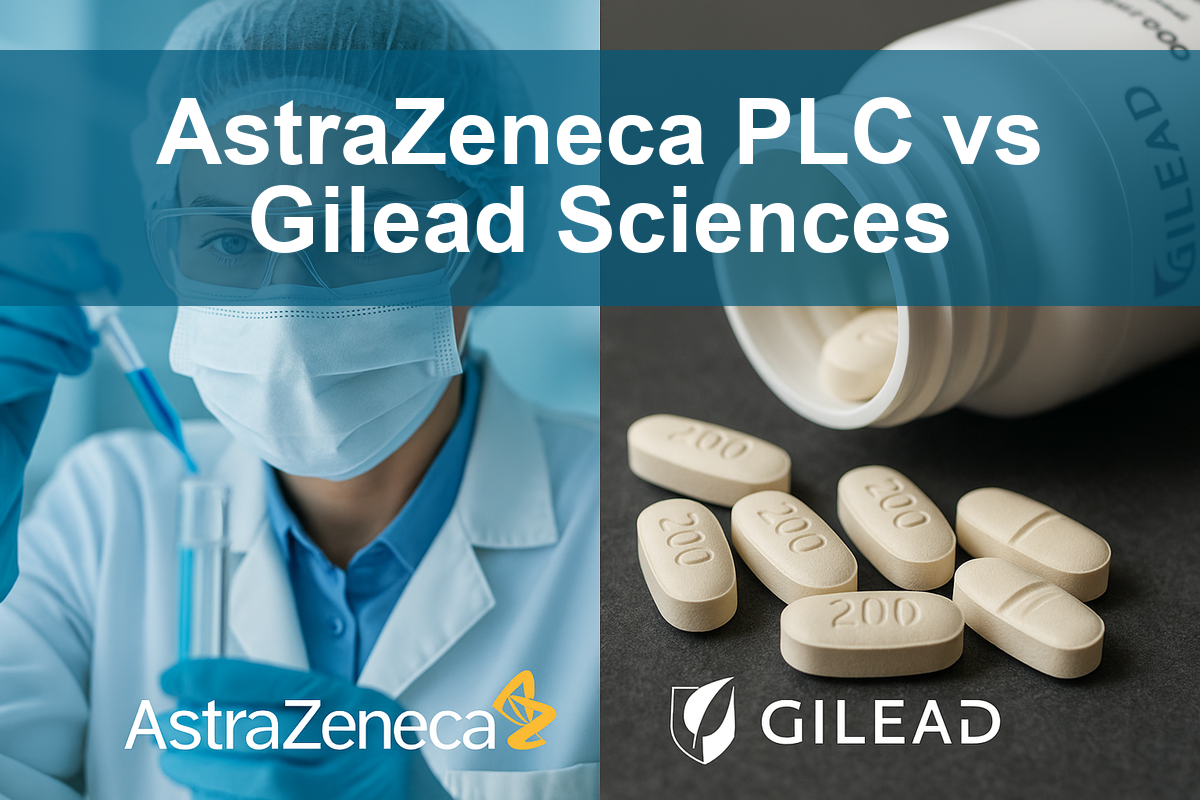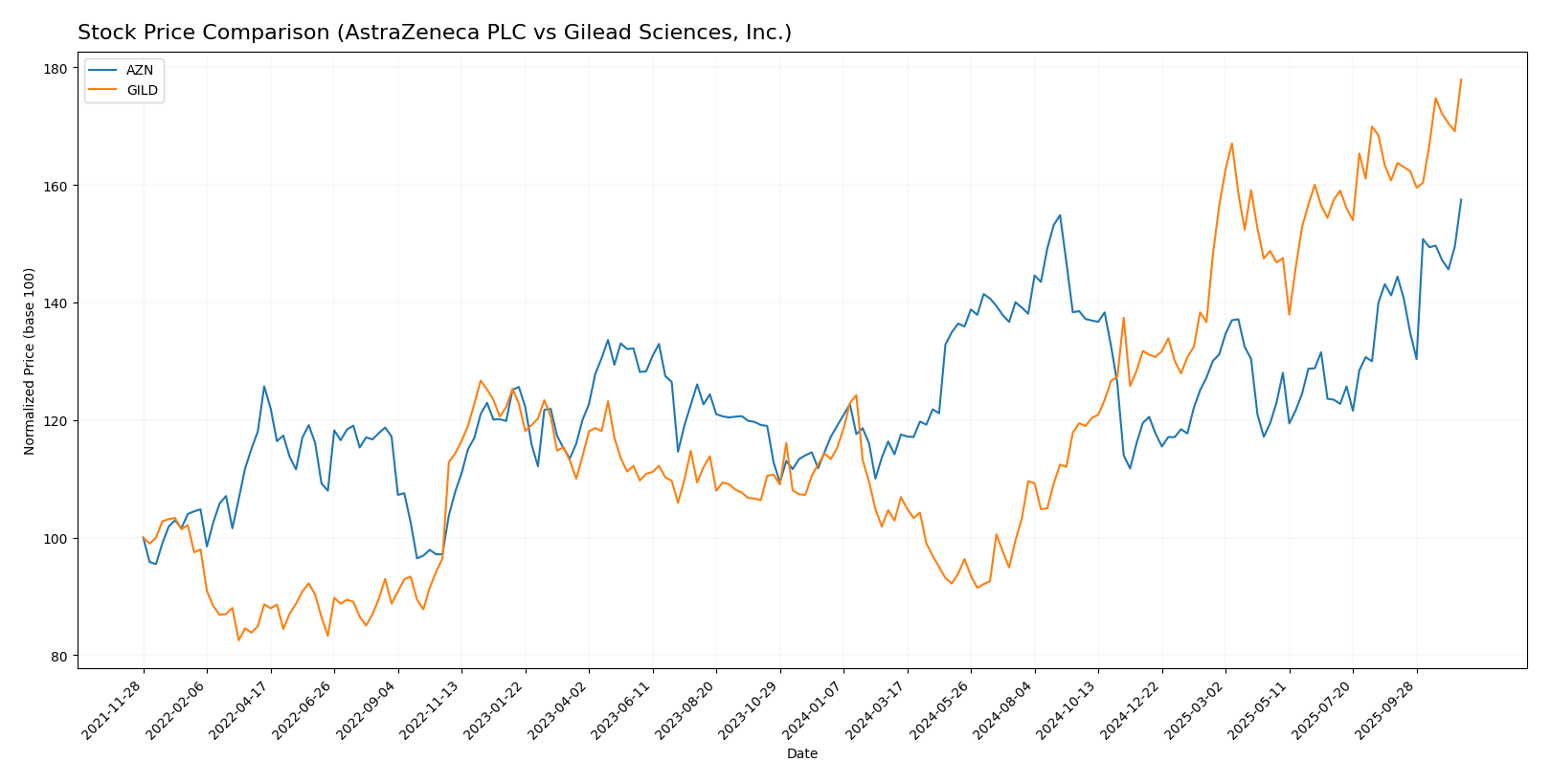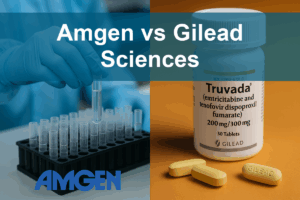In today’s fast-paced healthcare market, AstraZeneca PLC (AZN) and Gilead Sciences, Inc. (GILD) stand out as key players in the biopharmaceutical sector. Both companies share a focus on innovative drug development, addressing critical health needs across oncology, infectious diseases, and more. Their competitive landscapes and diverging strategies make them compelling subjects for comparison. Join me as we delve into the strengths and potentials of these two titans to determine which may be the more promising investment for your portfolio.

Table of contents
Company Overview
AstraZeneca PLC Overview
AstraZeneca PLC, headquartered in Cambridge, UK, is a leading biopharmaceutical company that emphasizes the discovery, development, manufacture, and commercialization of innovative prescription medicines. With a strong focus on areas such as oncology, cardiovascular, renal, and metabolic diseases, AstraZeneca has established a diverse portfolio of products, including Tagrisso and Imfinzi. The company has also expanded its market presence with vaccines and treatments for COVID-19 and rare diseases. AstraZeneca’s commitment to partnerships, including collaborations in AI-driven drug discovery, positions it as a forward-thinking organization in the healthcare sector.
Gilead Sciences, Inc. Overview
Gilead Sciences, Inc., based in Foster City, California, is a prominent biopharmaceutical firm specializing in the discovery, development, and commercialization of medicines addressing unmet medical needs globally. The company’s product range includes treatments for HIV/AIDS, liver diseases, and various cancers, with notable therapies such as Biktarvy and Veklury. Gilead’s strategic collaborations with other biopharmaceutical entities enhance its research capabilities and product offerings, consistently aiming to improve patient outcomes in critical therapeutic areas.
Key similarities between AstraZeneca and Gilead include their focus on innovative drug development and a commitment to addressing significant healthcare challenges. However, their business models differ slightly; AstraZeneca emphasizes a broader therapeutic range, while Gilead is more specialized in antiviral and oncology treatments.
Income Statement Comparison
The following table presents a comparison of the latest income statements for AstraZeneca PLC (AZN) and Gilead Sciences, Inc. (GILD), highlighting key financial metrics for the most recent fiscal year.
| Metric | AstraZeneca PLC (AZN) | Gilead Sciences, Inc. (GILD) |
|---|---|---|
| Revenue | 54.1B | 28.8B |
| EBITDA | 15.4B | 4.4B |
| EBIT | 10.4B | 1.7B |
| Net Income | 7.0B | 0.5B |
| EPS | 1.14 | 0.38 |
Interpretation of Income Statement
In 2024, AstraZeneca reported a notable revenue increase to 54.1B, up from 45.8B in 2023, reflecting a robust demand for its products. Gilead also saw growth, with revenue rising to 28.8B from 27.1B. However, Gilead’s net income of 0.5B indicates a significant decline compared to 5.7B in 2023, primarily due to increased operational costs. Meanwhile, AstraZeneca maintained healthy margins, with EBIT and EBITDA margins remaining stable. Gilead’s declining net income signals potential operational inefficiencies or increased competition, warranting caution for investors considering exposure to these stocks.
Financial Ratios Comparison
In this section, I present a comparative analysis of key financial metrics for AstraZeneca PLC (AZN) and Gilead Sciences, Inc. (GILD) based on the most recent data available.
| Metric | AstraZeneca PLC (AZN) | Gilead Sciences, Inc. (GILD) |
|---|---|---|
| ROE | 13.01% | 2.89% |
| ROIC | 16.18% | 8.61% |
| P/E | 28.87 | 17.85 |
| P/B | 4.98 | 4.43 |
| Current Ratio | 0.93 | 1.60 |
| Quick Ratio | 0.74 | 1.45 |
| D/E | 0.74 | 1.09 |
| Debt-to-Assets | 28.95% | 40.22% |
| Interest Coverage | 5.95 | 1.70 |
| Asset Turnover | 0.52 | 0.44 |
| Fixed Asset Turnover | 4.64 | 5.31 |
| Payout ratio | 65.80% | 67.24% |
| Dividend yield | 2.28% | 3.77% |
Interpretation of Financial Ratios
AstraZeneca shows stronger returns on equity (ROE) and invested capital (ROIC), indicating effective management of resources compared to Gilead. However, Gilead has a higher current ratio, suggesting better liquidity. AstraZeneca’s higher debt-to-assets ratio raises concerns about financial leverage, while Gilead’s interest coverage ratio is significantly lower, indicating potential risks in meeting debt obligations. Overall, both companies have solid fundamentals, but AstraZeneca’s growth metrics are more compelling.
Dividend and Shareholder Returns
AstraZeneca PLC (AZN) offers a dividend yield of 2.28% with a payout ratio close to 66%. This indicates a balanced approach to returning value while still investing in growth. Gilead Sciences, Inc. (GILD), on the other hand, provides a higher yield of 3.77% but has a payout ratio of 67%, suggesting a sustainable dividend strategy. Both companies also engage in share buybacks, enhancing shareholder value. Overall, their distributions support long-term value creation, balancing returns with growth initiatives.
Strategic Positioning
AstraZeneca PLC (AZN) holds a significant market share in oncology and respiratory therapies, positioning itself strongly against competitors like Gilead Sciences, Inc. (GILD). While AZN’s market cap stands at approximately $276B, GILD trails with around $155B. Both face competitive pressures from emerging biopharmaceuticals and technological disruptions, particularly in AI-driven drug development. As they innovate, maintaining a focus on unmet medical needs will be crucial for sustaining growth and market relevance.
Stock Comparison
In this section, I will analyze the stock price movements of AstraZeneca PLC (AZN) and Gilead Sciences, Inc. (GILD) over the past year, highlighting key dynamics in their trading performance.

Trend Analysis
AstraZeneca PLC (AZN) has experienced a price increase of 34.41% over the past year. The stock is currently in a bullish trend, with notable acceleration, as indicated by a standard deviation of 6.46. The highest price reached during this period was 89.1, while the lowest was 62.26. Recently, from August 31, 2025, to November 16, 2025, AZN recorded a price change of 11.51%, further reinforcing its bullish outlook.
Gilead Sciences, Inc. (GILD) has shown an even stronger performance, with a remarkable price increase of 56.94% over the same time frame. This stock is also classified as bullish, with acceleration noted and a standard deviation of 18.13. The highest price for GILD was 125.02, and the lowest was 64.27. From August 31, 2025, to November 16, 2025, GILD realized a 10.67% price change, confirming its bullish trend.
Both stocks exhibit significant upward trends, which could be appealing for investors looking for growth opportunities. However, I advise paying attention to the overall market conditions and individual stock volatility to manage risks effectively.
Analyst Opinions
Recent analyst recommendations highlight a split sentiment for two key players in the pharmaceutical sector. For AstraZeneca PLC (AZN), analysts rate it at B+, suggesting a cautious hold due to a strong return on equity and assets, but lower scores in price-to-earnings metrics. Gilead Sciences, Inc. (GILD) receives a stronger A- rating, indicating a buy consensus, driven by robust cash flow and equity performance. Overall, the consensus for GILD is a buy, while AZN leans towards a hold for the current year.
Stock Grades
In the current market, I have compiled the latest stock ratings from reputable grading companies for AstraZeneca PLC and Gilead Sciences, Inc.
AstraZeneca PLC Grades
| Grading Company | Action | New Grade | Date |
|---|---|---|---|
| UBS | upgrade | Buy | 2025-02-13 |
| UBS | upgrade | Neutral | 2024-11-20 |
| Erste Group | upgrade | Buy | 2024-09-11 |
| TD Cowen | maintain | Buy | 2024-08-12 |
| Argus Research | maintain | Buy | 2024-05-30 |
| BMO Capital | maintain | Outperform | 2024-04-26 |
| Deutsche Bank | upgrade | Hold | 2024-04-16 |
| BMO Capital | maintain | Outperform | 2024-02-12 |
| Deutsche Bank | downgrade | Hold | 2024-02-08 |
| Jefferies | downgrade | Hold | 2024-01-03 |
Gilead Sciences, Inc. Grades
| Grading Company | Action | New Grade | Date |
|---|---|---|---|
| Needham | maintain | Buy | 2025-11-13 |
| Truist Securities | maintain | Buy | 2025-11-03 |
| JP Morgan | maintain | Overweight | 2025-10-31 |
| Cantor Fitzgerald | maintain | Overweight | 2025-10-31 |
| RBC Capital | maintain | Sector Perform | 2025-10-31 |
| Needham | maintain | Buy | 2025-10-31 |
| Wells Fargo | maintain | Overweight | 2025-10-31 |
| TD Cowen | maintain | Buy | 2025-10-23 |
| Citigroup | maintain | Buy | 2025-10-08 |
| JP Morgan | maintain | Overweight | 2025-09-16 |
Overall, AstraZeneca has seen a positive shift in grades, moving from sell and hold ratings to more favorable buy recommendations. Gilead, on the other hand, has maintained a strong position with consistent buy and overweight ratings, indicating robust investor confidence.
Target Prices
The current consensus target prices for AstraZeneca PLC (AZN) and Gilead Sciences, Inc. (GILD) indicate bullish expectations from analysts.
| Company | Target High | Target Low | Consensus |
|---|---|---|---|
| AstraZeneca PLC | 97 | 97 | 97 |
| Gilead Sciences, Inc. | 147 | 105 | 127 |
For AstraZeneca, analysts project a target price of 97, aligning precisely with its current price of 89.1. In contrast, Gilead’s consensus of 127 suggests a potential upside compared to its current price of 125.02, reflecting positive market sentiment.
Strengths and Weaknesses
Here is a comparative analysis of the strengths and weaknesses of AstraZeneca PLC (AZN) and Gilead Sciences, Inc. (GILD).
| Criterion | AstraZeneca (AZN) | Gilead Sciences (GILD) |
|---|---|---|
| Diversification | High (broad product range across various therapeutic areas) | Moderate (focus on HIV, oncology, and liver diseases) |
| Profitability | Strong (net profit margin ~13%) | Moderate (net profit margin ~17%) |
| Innovation | High (investment in R&D, strong pipeline) | Moderate (steady product launches) |
| Global presence | Extensive (operations in multiple continents) | Strong (international operations, but slightly less global reach) |
| Market Share | Significant (leading position in multiple markets) | Strong (notable in HIV and oncology) |
| Debt level | Moderate (debt to equity ratio ~0.73) | High (debt to equity ratio ~1.38) |
Key takeaways: AstraZeneca shows strong diversification and innovation, while Gilead excels in profitability but carries a higher debt load. Both companies hold significant market positions, but their strategies and financial structures differ considerably.
Risk Analysis
The table below outlines key risks associated with AstraZeneca PLC (AZN) and Gilead Sciences, Inc. (GILD) as of the most recent fiscal year.
| Metric | AstraZeneca PLC (AZN) | Gilead Sciences, Inc. (GILD) |
|---|---|---|
| Market Risk | High | Moderate |
| Regulatory Risk | Moderate | High |
| Operational Risk | Moderate | Moderate |
| Environmental Risk | Low | Moderate |
| Geopolitical Risk | Moderate | High |
In synthesizing the risks, I note that both companies face substantial regulatory and geopolitical risks, especially given the evolving landscape of healthcare regulations and international relations. AstraZeneca’s low environmental risk contrasts with Gilead’s moderate exposure, indicating differences in operational impact.
Which one to choose?
When comparing AstraZeneca PLC (AZN) and Gilead Sciences, Inc. (GILD), GILD shows a stronger overall performance with a higher analyst rating of A- compared to AZN’s B+. In terms of profitability, GILD’s net profit margin is significantly higher at 20.89% versus AZN’s 13.01%, reflecting better operational efficiency. GILD also exhibits a solid trend with a price change of 56.94% over the last year, compared to AZN’s 34.41%. However, AZN has a more favorable debt-to-equity ratio, indicating lower financial risk.
For growth-focused investors, GILD appears favorable, while those prioritizing stability may consider AZN due to its lower debt levels. Each company faces risks such as competition in the pharmaceutical industry and dependency on market conditions.
Disclaimer: This article is not financial advice. Each investor is responsible for their own investment decisions.
Go further
I encourage you to read the complete analyses of AstraZeneca PLC and Gilead Sciences, Inc. to enhance your investment decisions:



